
Sir Antony Mark David Gormley is a British sculptor. His works include the Angel of the North, a public sculpture in Gateshead in the north of England, commissioned in 1994 and erected in February 1998; Another Place on Crosby Beach near Liverpool; and Event Horizon, a multipart site installation which premiered in London in 2007, then subsequently in Madison Square in New York City (2010), São Paulo, Brazil (2012), and Hong Kong (2015–16).

Centenary Square is a public square on the north side of Broad Street in Birmingham, England, named in 1989 to commemorate the centenary of Birmingham achieving city status. The area was an industrial area of small workshops and canal wharves before it was purchased by the council in the 1920s for the creation of a grand civic centre scheme to include museums, council offices, cathedral and opera house. The scheme was abandoned after the arrival of World War II with only the Hall of Memory and half of the planned Baskerville House complete. After the war the scheme was revived in a simpler form however the council never managed to implement the design.
The year 1985 in architecture involved some significant architectural events and new buildings.

The Ikon Gallery is an English gallery of contemporary art, located in Brindleyplace, Birmingham. It is housed in the Grade II listed, neo-gothic former Oozells Street Board School, designed by John Henry Chamberlain in 1877.

The Royal Institute of British Architects (RIBA) is a professional body for architects primarily in the United Kingdom, but also internationally, founded for the advancement of architecture under its royal charter granted in 1837, three supplemental charters and a new charter granted in 1971.

Associated Architects is a leading AJ100 architectural firm with offices in Birmingham and Leeds, England. Founded in 1968, the practice has a broad portfolio of work including arts, commercial offices, residential, masterplanning and leisure and is particularly known for its work in education. It has received many national awards including over 30 RIBA Awards, together with the RIBA Sustainability Award. For its commercial work it has been awarded nine BCO Awards. The practice designed the George Davies Centre, at the University of Leicester, currently the largest (non-domestic) building in the UK to be Passivhaus accredited. It is also responsible for the design and delivery of Bartholomew Barn, the UK's first "multi-comfort" building, a benchmark pioneered by Saint Gobain. The building has set a new bar for sustainable architecture.
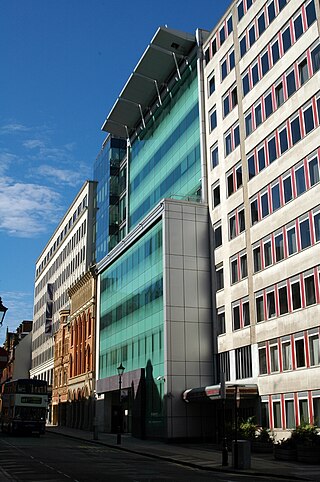
Edmund Street is a street located in Birmingham, England.

The Cathedral Quarter in Belfast, Northern Ireland, is a developing area of the city, roughly situated between Royal Avenue near where the Belfast Central Library building is, and the Dunbar Link in the city centre. From one of its corners, the junction of Royal Avenue, Donegall Street and York Street, the Cathedral Quarter lies south and east. Part of the area, centred on Talbot Street behind the cathedral, was formerly called the Half Bap. The "Little Italy" area was on the opposite side of Great Patrick Street centred on Little Patrick Street and Nelson Street.
Cameron Sinclair is a Scottish composer, conductor and percussionist based in London.

Sutton Coldfield Town Hall is a former hotel and council building in Sutton Coldfield, Birmingham, England. The building is Grade A locally listed.
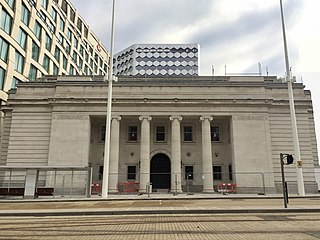
The Birmingham Municipal Bank was a savings bank in the city of Birmingham, England. It was created as the Birmingham Corporation Savings Bank by a 1916 Act of Parliament on a temporary basis and replaced by the Birmingham Municipal Bank in 1919. In 1976 it converted into a trustee savings bank.

Birmingham is a city and metropolitan borough in the metropolitan county of West Midlands in England. It is the second-largest city in Britain – commonly referred to as the second city of the United Kingdom – with a population of 1.145 million in the city proper. Birmingham borders the Black Country to its west and, together with the city of Wolverhampton and towns including Dudley and Solihull, forms the West Midlands conurbation. The wider metropolitan area has a population of 4.3 million, making it the largest outside of London.
Thomas Cecil Howitt, OBE was a British provincial architect of the 20th Century. Howitt is chiefly remembered for designing prominent public buildings, such as the Council House and Processional Way in Nottingham, Baskerville House in Birmingham, Newport Civic Centre, and several Odeon cinemas. Howitt's chief architectural legacies are in his home city of Nottingham. He was Housing Architect for the City Council, designing municipal housing estates which are often considered to be among the finest in terms of planning in the country.

Regal Tower is a proposed skyscraper to be constructed on a site bounded by Broad Street, Oozells Way and Sheepcote Street in Ladywood, just outside of Central Birmingham, England. The proposal consists of a 56 storey tower, measuring 200.5 metres (658 ft) tall, housing retail units, a luxury hotel, residential apartments and car parking. Provision has been made for 256 serviced apartments, although these could make way for additional hotel space. The tower has been designed by Aedas and was proposed by Regal Property Group, with DTZ Debenham Tie Leung acting on their behalf. If completed as originally planned, the skyscraper would be the second tallest building in the UK outside of London.

Feilden Clegg Bradley Studios is a British architectural design firm, established in 1978, with offices in Bath, London, Manchester and Belfast. The firm is known for its pioneering work in sustainable design and social design agenda.
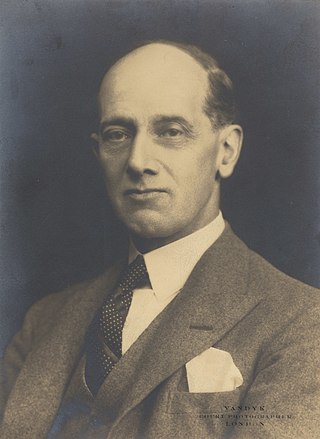
William Curtis Green was an English architect, designer and barrister who was based in London for much of his career. His works include the Dorchester Hotel, Wolseley House, New Scotland Yard, and the buildings, including the former Manor House, in Stockgrove Country Park. He was awarded the Royal Gold Medal in 1942. Around 20 of his designs are listed buildings. He is the younger brother of the craftsman and furniture designer Arthur Romney Green.
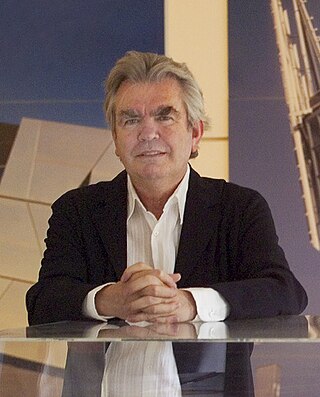
Sir Terence Farrell, known as Terry Farrell, is a British architect and urban designer. In 1980, after working for 15 years in partnership with Sir Nicholas Grimshaw, Farrell founded his own firm, Farrells. He established his reputation with three completed projects in London in the late 1980s: Embankment Place, 125 London Wall aka Alban Gate and SIS Building aka Vauxhall Cross.
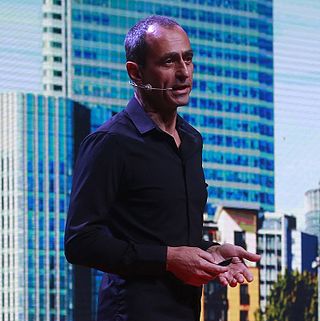
Keith Griffiths RIBA FHKIA is a Welsh architect who founded and chairs Aedas. Since 1983 and for most of his career he has resided in Hong Kong.

The Taichung Commercial Bank Headquarters, also known as Taichung Diamond is an under construction skyscraper located in Taichung's 7th Redevelopment Zone, Xitun District, Taichung, Taiwan. It will be the tallest building in Taichung and the first building to surpass 200 m (660 ft) in Taichung. Designed by Aedas, the architectural height of building is 225 m (738 ft), the floor area is 115,310 m2 (1,241,200 sq ft), and it comprises 38 floors above ground, as well as 10 basement levels. It will be completed in 2023 and will become the headquarter of Taichung Bank as well as housing a luxury hotel.

The Midland Bank, 27-35 Poultry stands on Poultry in the City of London. It was built between 1924 and 1929 as the headquarters offices of the Midland Bank. The architect was Edwin Lutyens. A Grade I listed building, its Historic England record describes it as one of Lutyens' "finest urban buildings". It is now a hotel, The Ned, named in Lutyens' honour.




















